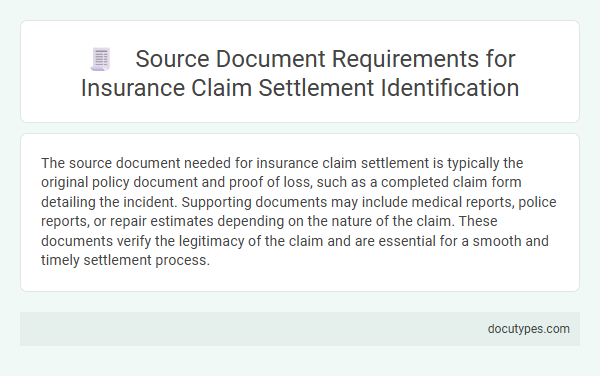The source document needed for insurance claim settlement is typically the original policy document and proof of loss, such as a completed claim form detailing the incident. Supporting documents may include medical reports, police reports, or repair estimates depending on the nature of the claim. These documents verify the legitimacy of the claim and are essential for a smooth and timely settlement process.
Introduction to Source Document Requirements
Source documents are essential for validating and processing insurance claims accurately. These documents provide the necessary proof of loss and support the claim settlement process.
Common source documents include police reports, medical certificates, repair estimates, and bills. Insurers require these documents to verify the authenticity and extent of the claim. Proper documentation helps prevent fraud and ensures timely claim settlement.
Importance of Proper Documentation in Insurance Claims
Proper documentation serves as the backbone of a smooth insurance claim settlement process. Source documents like medical bills, accident reports, and policy papers provide verifiable proof essential for claim evaluation.
Submitting accurate source documents reduces processing delays and minimizes dispute risks. Insurers rely heavily on these records to validate claims and ensure rightful compensation is disbursed.
Key Identification Documents Needed
Insurance claim settlement requires key identification documents to verify the claimant's identity and policy details. Primary documents include a government-issued ID such as a passport, driver's license, or national identity card. Policyholders must also provide the original insurance policy document and any claim-specific forms or proofs as mandated by the insurer.
Policyholder Verification Procedures
Source documents play a crucial role in the insurance claim settlement process by verifying the policyholder's identity and eligibility. Your insurance provider requires specific documents to authenticate your claim and proceed with settlement efficiently.
- Government-issued ID - Confirms the policyholder's identity through official photo identification such as a passport or driver's license.
- Policy Document - Provides proof of insurance coverage and policy details necessary to validate the claim.
- Claim Form - Contains essential information signed by the policyholder to initiate and verify the claim request.
Required Supporting Evidence for Claims
| Source Document | Purpose | Details Required | Importance for Insurance Claim Settlement |
|---|---|---|---|
| Insurance Policy Document | Proof of coverage | Policy number, insured sum, coverage terms, effective dates | Defines the scope and limits of the claim and eligibility criteria |
| Claim Form | Formal request for claim processing | Personal details, claim type, incident description, signature | Essential for initiating the claim and recording claimant's details |
| Accident or Incident Report | Evidence of event occurrence | Date, time, location, involved parties, cause description | Validates the event for claim admissibility |
| Medical Reports and Bills | Proof of injury and treatment | Diagnosis, treatment details, service dates, expenses incurred | Supports claims related to personal injury and medical expenses |
| Police Report | Official record for criminal or accident claims | Report number, investigation details, involved parties | Strengthens legitimacy for claims involving theft, accidents, or illegal acts |
| Repair or Replacement Estimates | Cost assessment for property damage claims | Item description, damage details, repair costs, vendor information | Facilitates accurate compensation calculation |
| Proof of Ownership | Verification of insured item ownership | Receipts, purchase invoices, registration documents | Prevents fraudulent claims and confirms asset ownership |
| Bank Statements or Payment Receipts | Verification of expenses paid | Transaction details, dates, amounts paid | Ensures claimed expenses are legitimate and paid by insured |
Acceptable Forms of Personal Identification
Insurance claim settlements require valid source documents to verify your identity accurately. Acceptable forms of personal identification ensure the claim process is secure and efficient.
- Government-Issued Photo ID - A valid passport, driver's license, or state ID card provides official proof of identity.
- Social Security Card - Used to confirm your social security number as part of identity verification.
- Birth Certificate - Serves as a legal record of your identity, especially when other photo IDs are unavailable.
Document Authentication and Validation
What source document is needed for insurance claim settlement? The primary source document required is the original policy certificate that verifies the insured coverage. Authentication and validation of this document ensure the claimant's entitlement and prevent fraudulent claims.
Common Document Submission Errors
Submitting the correct source documents is crucial for a smooth insurance claim settlement process. Common documents include the insurance policy, claim form, and proof of loss.
Errors in document submission often cause delays and rejections. Frequent mistakes involve incomplete forms, missing signatures, and unclear copies of required documents.
Digital vs. Physical Document Requirements
Source documents are essential for insurance claim settlement, serving as proof of the event and loss incurred. Digital documents like scanned receipts, photos, and electronic medical records are increasingly accepted due to convenience and faster processing times. Physical documents, such as original invoices and signed forms, may still be required in certain cases to verify authenticity and comply with regulatory standards.
What Source Document Is Needed for Insurance Claim Settlement? Infographic

